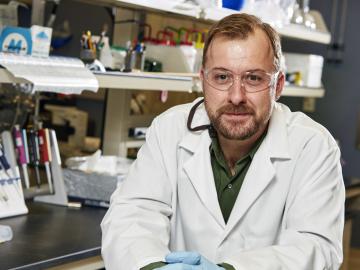
Filter News
Area of Research
- (-) Clean Energy (168)
- (-) Geographic Information Science and Technology (1)
- (-) Materials (122)
- Advanced Manufacturing (5)
- Biological Systems (1)
- Biology and Environment (102)
- Biology and Soft Matter (4)
- Building Technologies (2)
- Chemical and Engineering Materials (3)
- Chemistry and Physics at Interfaces (7)
- Climate and Environmental Systems (7)
- Computational Biology (1)
- Computational Chemistry (5)
- Computational Engineering (1)
- Computer Science (3)
- Data (1)
- Earth Sciences (1)
- Electricity and Smart Grid (1)
- Energy Frontier Research Centers (7)
- Fuel Cycle Science and Technology (2)
- Functional Materials for Energy (8)
- Fusion and Fission (33)
- Fusion Energy (7)
- Isotopes (22)
- Materials for Computing (13)
- Materials Synthesis from Atoms to Systems (8)
- Materials Under Extremes (7)
- National Security (47)
- Neutron Data Analysis and Visualization (2)
- Neutron Science (73)
- Nuclear Science and Technology (27)
- Quantum Condensed Matter (3)
- Quantum information Science (4)
- Renewable Energy (2)
- Sensors and Controls (2)
- Supercomputing (154)
- Transportation Systems (4)
News Type
News Topics
- 3-D Printing/Advanced Manufacturing (25)
- Advanced Reactors (3)
- Artificial Intelligence (5)
- Big Data (2)
- Bioenergy (11)
- Biology (4)
- Biomedical (4)
- Biotechnology (1)
- Buildings (11)
- Chemical Sciences (8)
- Clean Water (5)
- Climate Change (8)
- Composites (3)
- Computer Science (13)
- Coronavirus (6)
- Cybersecurity (6)
- Decarbonization (15)
- Energy Storage (22)
- Environment (23)
- Exascale Computing (1)
- Fossil Energy (1)
- Fusion (2)
- Grid (13)
- High-Performance Computing (3)
- Isotopes (6)
- Machine Learning (2)
- Materials (24)
- Materials Science (20)
- Mathematics (2)
- Mercury (1)
- Microelectronics (1)
- Microscopy (8)
- Nanotechnology (9)
- National Security (1)
- Net Zero (1)
- Neutron Science (11)
- Nuclear Energy (11)
- Partnerships (5)
- Physics (11)
- Polymers (4)
- Quantum Computing (1)
- Quantum Science (1)
- Security (4)
- Simulation (1)
- Space Exploration (2)
- Summit (3)
- Sustainable Energy (15)
- Transformational Challenge Reactor (2)
- Transportation (19)
Media Contacts

With more than 30 patents, James Klett is no stranger to success, but perhaps the Oak Ridge National Laboratory researcher’s most noteworthy achievement didn’t start out so hot – or so it seemed at the time.

Andrew Stack, a geochemist at the Department of Energy’s Oak Ridge National Laboratory, advances understanding of the dynamics of minerals underground.

Scientists who bridge disciplines often take research in new directions. Andrew Stack of the Department of Energy’s Oak Ridge National Laboratory calls on his expertise in geology, chemistry and computing to advance understanding of the dynamics of minerals underground. Working in the Geochemistry a...







A new concept in metallic alloy design – called “high-entropy alloys” - has yielded a multiple-element material that not only tests out as one of the toughest on record, but, unlike most materials, the toughness as well as the strength and ductility


